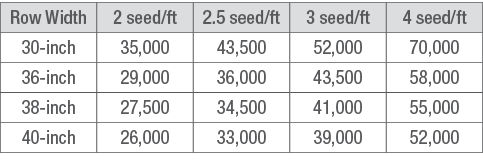5 MIN READ
Cotton Seeding Rate and Row Spacing
February 21, 2023
- Improvements in yield potential and trait technology have increased seed costs on the farm. Cotton growers want to know if lower plant populations can help offset seed costs while maintaining yield potential.
- It is critical to determine the optimal seeding rate and row spacing for production efficiency, management, and economic return.
- There are many factors to consider including growing conditions, pest pressure, management preferences, and yield go.
The Impact of High and Low Plant Populations
High final plant populations tend to have taller, more upright plants and require aggressive management. Cotton production with higher plant densities should occur with the appropriate variety selection. When cotton plant populations are high, the following can occur:
- More first position bolls are set, which can lead to increased harvest efficiency with first position bolls maturing first. Fiber quality can be higher because bolls have matured around the same time.1
- Later initiation of fruiting with a somewhat shortened boll loading period due to time constraints at the end of the season.
- Decreased drought tolerance.
- Increased fruit shedding due to difficult-to-control plants from mid- to late-season.
- More aggressive plant growth regulator (PGR) use during the growing season.
- Increased number of small bolls, which can lower harvest efficiency as lint is more difficult to obtain from smaller bolls.1
Cotton planted at lower densities have branchier growth that help compensate for skips in the field or lower plant populations. This ability is limited and comes with its own considerations. Lower plant populations can lead to:
- Increased growth of vegetative and fruiting branches. Larger branches and stems can lower harvest efficiency.
- Increased secondary and tertiary boll production. Waiting on these bolls to mature can delay harvest and impact fiber quality due to the variation in lint maturity.1 Low populations require time to accumulate a fruit load necessary for optimal yield. Additional time can add management challenges in late-planted or short-season situations.
- Shorter plants due to increased lateral branching, which often results in lower PGR requirements.
- Increased boll retention.1
Local Seeding Rate Considerations
Certain conditions can influence cotton seeding rates depending on management system/style, variety characteristics, projected weather patterns, and planting date. Some of these specific conditions include:
Early planting. A challenge of early planting is the ability to establish and maintain an adequate stand in the face of seedling disease, cold weather, and generally difficult establishment conditions. In the case of early planting into adverse conditions, seeding rates should be increased to compensate for potential losses.
A short growing season. This scenario includes any case where earliness is at a premium. Cotton planted late or in areas with a historically shorter growing season generally fall into this category. In cases where earliness is required, planting higher seeding rates, in combination with aggressive in-crop management and variety selection can help with earliness while maintaining adequate yield potential. Having more plants in the field allows a relatively high level of yield accumulation in shorter periods of time as compared to less dense stands. This ultimately allows for an earlier crop to be harvested.
Planting on “growthy” soil types. Highly productive soils that have demonstrated the need for aggressive growth control in the past often benefit from lower seeding rates. Fewer plants create less competition for resources and usually require less growth control.
High input, high yield environments. These production environments require the most aggressive decision making, management inputs, and carry somewhat higher risk. In this scenario, desired final plant populations are generally above average for a region. These fields are ideal for cotton production and are very aggressively managed with PGRs, fertility, chemical control, and irrigation applications. These factors influence the outcome of a crop in any field, but in this environment, having relatively high numbers of surviving plants establishes the yield potential early in the season.
Final Seeding Rate Calculations
Setting a target final plant population can be accomplished by calculating a target number of plants per acre based on desired seed per foot. Seeding rates vary greatly across the cotton growing area and are based on historical planting conditions that support or limit stand establishment. It is recommended to plant roughly 20% over the target plant population to account for any minor issues at planting.2 Seeding rates can be adjusted as weather conditions change.
Minimum final plant populations can vary across the cotton growing area. North Carolina State University recommends a minimum of 30,000 plant per acre to maintain yield potential.2 Mississippi State University recommends a minimum of 15,000 plants per acre.4 These minimum populations require optimal growing conditions (high quality seed, warm soil temperatures, positive weather forecast) and even plant distribution throughout the field. Final plant populations that are lower than expected should be assessed to determine if replanting is necessary.







